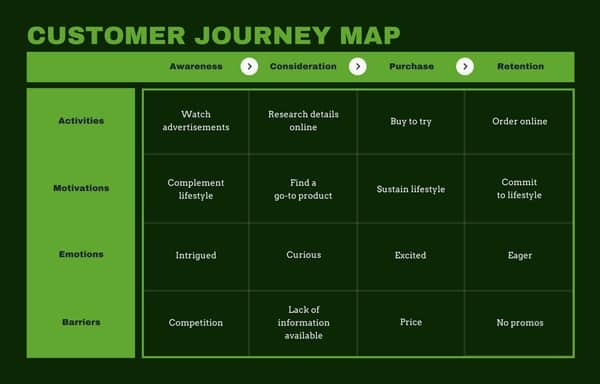You may be wondering where to start with your business and marketing strategies. There are some critical components to building your strategy for the month, quarter, year, and so on. These components give you a target audience to aim for. These are your customers, stakeholders, enthusiasts and other types of people. They are what make up the ‘market’ in Product-Market Fit (PMF).
So, to understand some of the basics and critical elements of designing your strategy to touch your customers at the right stage, let’s define:
- Demand
- Customer profiles
- Customer journey
- Touchpoints
Demand
What is customer demand? This may seem obvious (or maybe you remember this from the supply-demand graphs in economics class), but demand is the general need for a given product or solution by the public. Part of knowing your customer, outside of the customer profile, relies heavily on the general demand for your product to exist. If it doesn’t it can require a bit of marketing, branding, and PR to get things moving.
How to measure demand for your product or service? To understand your customer, first, you must be able to come up with a theory about the demand for your product based on evidence. When we work with a new client, one of the things we talk about is demand. We look for ways to measure how many people can use your product or service. This is called Market Share. We will talk to you more about that in our onboarding session.
Customer Profiles
How do you make a customer profile? While no two companies have the same methods of creating customer profiles, the need for them is critical. Some say that you should have multiple customer profiles while others say you only need one primary profile. The best way to make a customer profile is using data which you already have access to. If you are already making sales or gaining interest, you can start with those people. Otherwise, you may start with some hypothetical profiles that adapt and change while you learn about your customer. Traditionally, companies will have names to identify a customer profile such as Anne, John, Mallory, etc…
What is a customer profile? Each profile represents a type of customer with a given set of characteristics. For instance, Anne may be a frequent Facebook user and is most likely to buy products from ads on Facebook. John may live far outside any city and relies mostly on direct mail. Mallory might be someone who makes more than $100K per year and enjoys buying things from Amazon. Dynamic customer profiles are now possible as well. This means every action that is tracked adds more color to the customer’s profile in real-time.
Demographics typically play a role in defining the customer as they can help to represent the average customer type predictably. Things like income, household worth, location, age, gender, life events, and other types of characteristics help to find people when they are most likely to buy your product or service.
What is the difference between B2B and B2C customers? If you are B2B, these are slightly different, but sometimes have some overlap. Your customer profile may be a business rather than a person. In that case, you will be looking for characteristics like the number of employees, yearly gross revenue, industry, and other characteristics that match the features of your product.
Customer Journey
What is a customer journey? A customer journey is the steps that a customer takes before making a purchase of your product or service. This includes several interactions with the brand which can start as subtly as seeing a logo on a coffee mug. From there a potential customer may see an advertisement for the company and learn a little more about what the company does. From there the situation may arise which triggers the potential customer to look into the product the company offers. At which point the customer reaches out and is entered into the inbound sales funnel.
How to make (map out) a customer journey? When you map out a customer journey you want to include all potential interactions (touchpoints). You also want to indicate what level of interest the potential customer has at each touch point. Sometimes called low to high intent or cold to warm leads. There are many ways to describe the steps, but the key is to figure out what interactions or steps your customer profiles are most likely going to touch. Finding those can take time and history to get the right. Once there is some history you can refine and optimize your journey to be customized for your customer profiles.
How to analyze a customer journey? This standard is set by the marketing team in charge of tracking the customer journey. Sometimes it is a booklet or document, sometimes it is a spreadsheet with some key figures that are updated regularly, and sometimes it is a piece of software like a CRM or marketing automation system stack such as Salesforce, Marketo, Pardot, SugarCRM, Insightly, or other CRM with dynamic tracking. To begin to analyze the customer journey it is important to have a baseline of data to compare against as you progress month over month and year over year.
Touchpoints
What are customer touchpoints? Touchpoints are mediums or places where a customer has interacted with your brands. Specifically, advertising, email, billboards, tv commercials, social media, websites, are all considered touchpoints. However, there are hundreds of potential touchpoints.
Do you want to maximize your understanding of your customer and build a strategy for success? We can develop a marketing plan that matches your product to your customer. Contact us to learn more!

